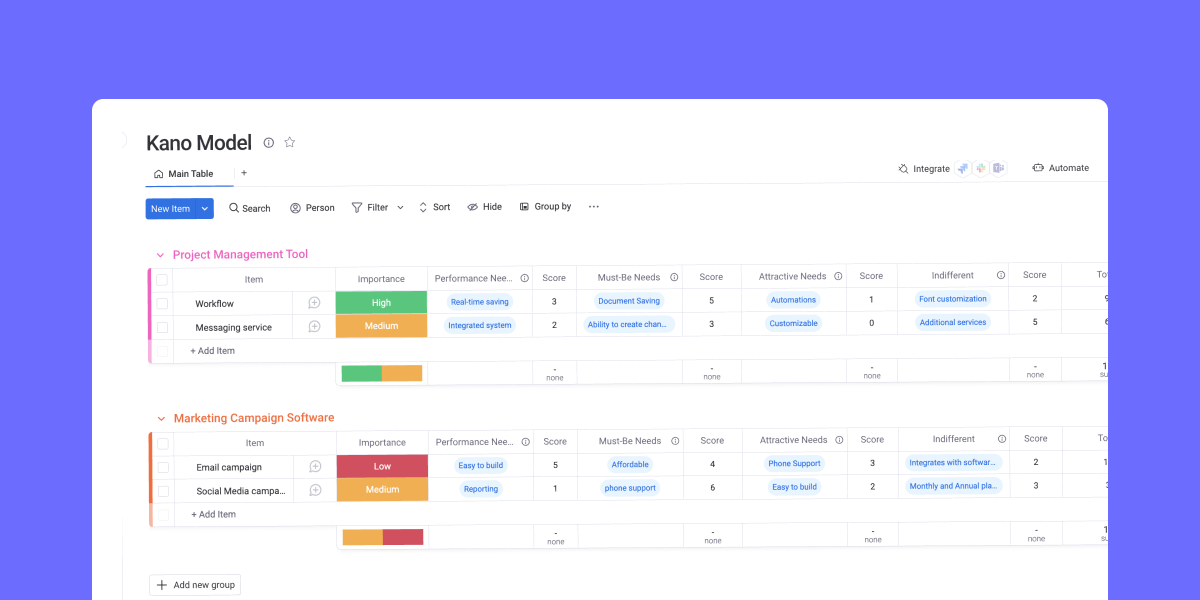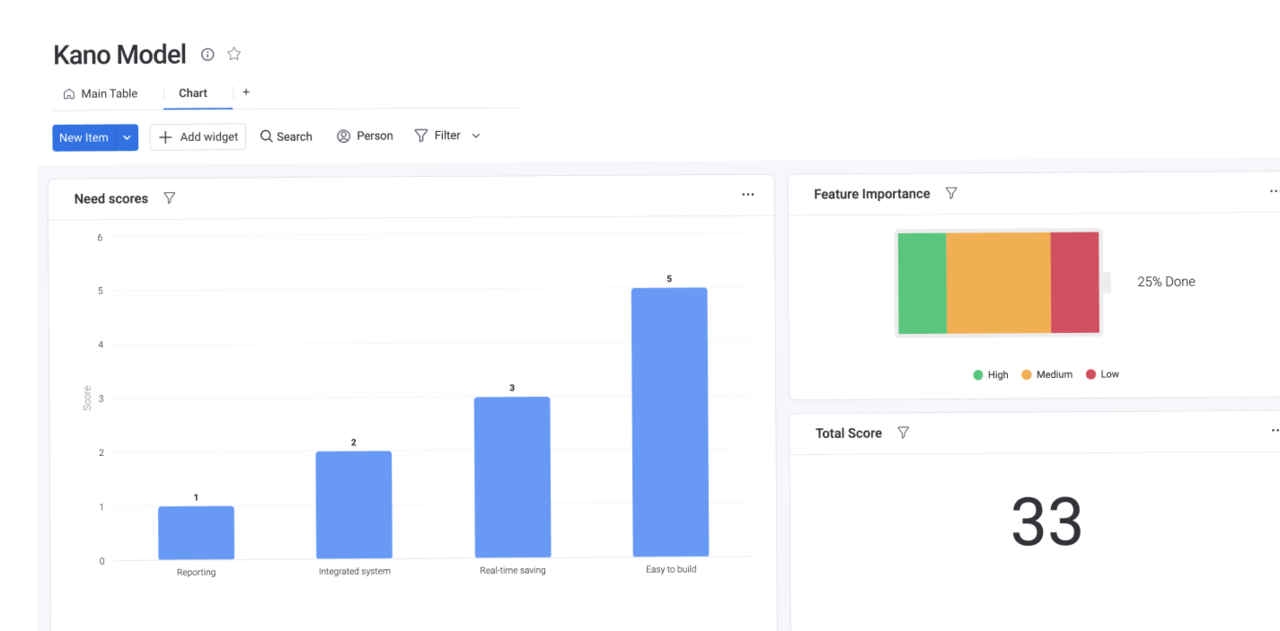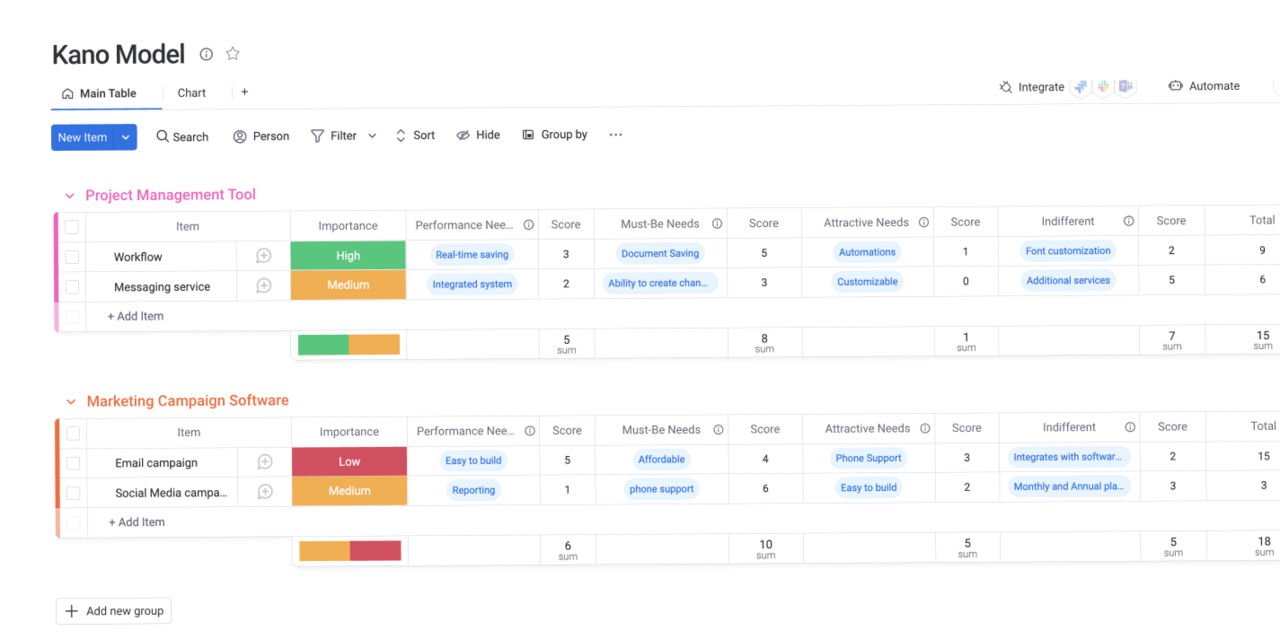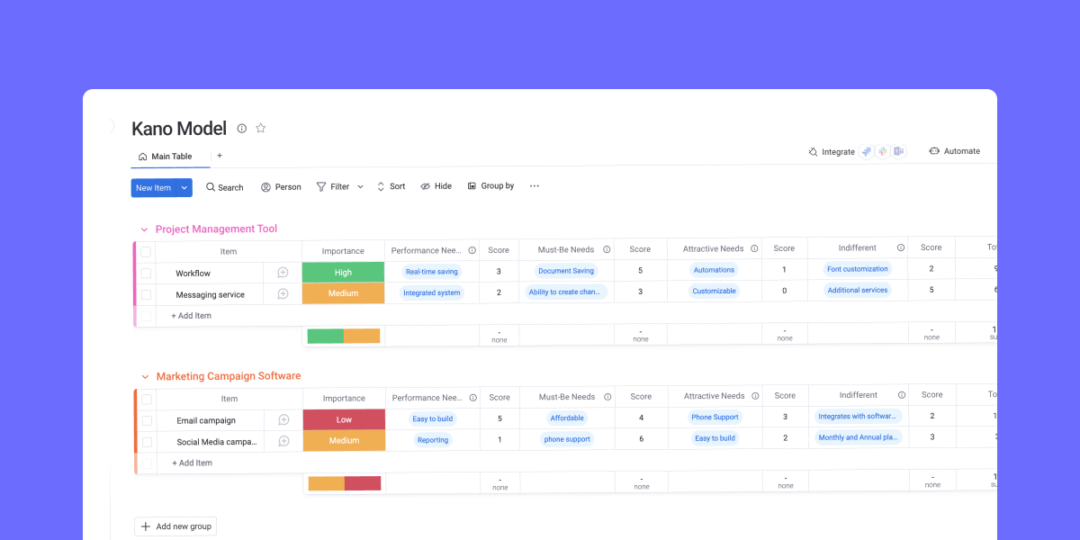Establish product development clout with the Kano model
Blog: Monday Project Management Blog

Creating a great product that people love is arduous work with no promise of success. Yet, one of the main reasons product developers and startups launch new products to lukewarm reception is that they didn’t validate and refine their idea before they started building. Ensuring your idea has an audience and figuring out exactly what those customers want is the single most important step of product development.
One of the most effective ways of validating product ideas is by leveraging a Kano model template. The Kano model helps uncover insights into your potential customer’s needs, desires, and pain points. In this guide, we’ll explain Kano models in detail and show you how to apply the concept to help secure a winning product launch. But first, a definition.
What is a Kano model template?
A Kano model template helps teams ascertain which product features are most likely to please and delight customers, providing strategic insights into product development.
In 1984, Dr. Noriaki Kano theorized a model which he used to gauge and measure the attributes of products that customers find valuable. This theory identifies three distinct measures of customer expectations: delighters, satisfiers, and basics. The Kano model is represented on a quadrant graph with two intersecting axes, the horizontal axis representing fulfillment and the vertical axis representing satisfaction. Products in the bottom left of the quadrant are unfulfilling and unsatisfying while those in the upper right are fulfilling and delightful. Finally, product features are described and graphed onto the quadrant according to five attributes:
- Must-have: This attribute, as the name implies, are absolute requirements that every customer expects based on the class of product. Without them, a product is a non-starter.
- One-dimensional: This attribute directly impacts product performance, customer satisfaction, and functionality. Customers are satisfied when products fulfill this attribute and are equally dissatisfied when they don’t.
- Attractive: Products with this attribute delight customers, though the attribute’s absence doesn’t cause dissatisfaction. Attractive attributes are qualities customers normally wouldn’t expect.
- Indifferent: This attribute has no impact on a customer’s delight or discontent. It describes details that customers either aren’t aware of or simply don’t care about.
- Reverse: Lastly, this attribute could be used to describe niche products where a product delivers high satisfaction to one group of customers while leaving another highly dissatisfied.
With a Kano model template, teams can discern which attributes in their products contribute the most to customer satisfaction, even if their presence isn’t mandatory. Likewise, they can identify the attribute that causes the most discontentment. This provides them with insights on precisely where to focus product development resources.
Why use a Kano model template?
In practical terms, a Kano model template relies on consumer input and feedback. The model itself is useless without adequate data to map features to attributes. Getting this information requires validation before and throughout product development. This requires significant research across channels and through qualitative and quantitative surveys and questionnaires. This data allows product teams to plot the attributes their audience is most concerned with, good or bad. From there, teams can make decisions that eventually lead to product success.
While extensive customer research requires more time and resources, it’s an investment that returns dividends. When you know what your customer wants and doesn’t want, you know how to allocate development resources more strategically. Once teams master customer research and Kano model analysis, their confidence in evaluating whether a feature will satisfy their customers’ needs grows. This alone makes the process worth exploring, which we’ll do by way of example.
What’s an example of a Kano model template in action?

Kano model analysis is important for understanding customer needs and desires. It’s used across various industries for gauging customer satisfaction. But in the early stages of product development, teams should focus on customer needs, wants, and expectations first and foremost.
1. Determine your customer’s requirements
First things first: You need to document customer requirements that you can test. Looking at your competition is a great place to start as it can help tease out the qualities and features your customers consider delightful, satisfying, or basic. You should also include requirements from the product team since the customer research process will either validate or invalidate presuppositions.
2. Develop surveys and questionnaires
Next, take the requirements you compiled and create surveys. Be sure to use a reliable mechanism for collecting responses to these questionnaires as this is the information that will guide your product’s development. It’s also a good idea to create opposing questions for each requirement to reduce bias.
3. Survey your target customers and document the results
Now comes the actual market research. Get your surveys and questionnaires into as many of your potential customer’s hands as possible. If you have the resources, in-person interviews are an excellent way to infer customer desires. Customers always know what they want, they just don’t always know how to express those wants. As you collect data, you can start classifying it into Kano’s five attributes while maintaining the essential core of the product you’re building. Pay special attention to the one-dimensional, attractive, and must-have attributes that will make your product stand out.
4. Evaluate your findings with a Kano model template
The difficult part of Kano analysis is over. You can now plot your findings on a Kano model template, classifying each of your initial features according to their attributes. This moment of truth will validate or invalidate your team’s feature assessment as well as shed new light on features you hadn’t considered. When you’re finished, you’ll have the foundations of a product strategy and roadmap validated with real customer data. While the process requires a considerable amount of time and resources, it’s far more costly to develop a product blindly. That said, a great Work OS is invaluable during every stage of a Kano analysis.
Kano model templates on monday.com

From user research and Kano analysis to launch day, monday.com has everything a product team needs to deliver the goods. Powerful yet intuitive task boards provide you with a niche-agnostic approach for any project or activity required for product development. And with hundreds of templates to choose from, getting started is a few clicks away. During the customer research stages of product development, monday.com facilitates every possible aspect, from research proposals to documentation. You can even use monday.com forms for your surveys and questionnaires. With all your data from start to finish stored on a single Work OS, you can rest assured your product validation efforts are fruitful.
Related templates on monday.com
To see just how impactful monday.com could be in your product development endeavor, check out these fully customizable templates for your product roadmap and marketing launch.
Product roadmap template
With your Kano analysis complete, you can use your new insights and our Product Roadmap Template to plot a path to success. Use it to maintain a bird’s eye view of your product’s development in real time. Manage timelines while prioritizing features in task boards as your team moves from task to task. And with built-in automation that can notify the next person in the task chain, no shoulder taps are necessary.
Product marketing launch template
Your marketing launch is an essential ingredient to your product’s success, so go ahead and add our Product Marketing Launch Template to your workspace and link it to your roadmap. This template has everything you need to plan your marketing strategy down to the last detail. Easily visualize every stage, coordinate with creative teams, and keep an eye on campaign performance as launch day draws near. Managing everything under a single digital roof means you and the rest of your team are always in sync.
Frequently asked questions
If you want to deepen your knowledge about Kano model templates, check out the most frequently asked questions about the methodology.
How do I make Kano models in Excel?
Unfortunately, Excel doesn’t support the quadrant graph required for the Kano model. While there are workarounds involving scatter charts, the process is fairly complicated. That said, the significant part of the Kano model is understanding the categories and collecting real-world data.
What’s the main objective of the Kano model?
The objective of the Kano model is to provide insights into product development by measuring the attributes and qualities that customers find valuable. On one hand, you could say the objective is to help product developers create great products. On the other hand, the model’s focus is on providing customer value. In this sense, the objective of the Kano model is to serve the customer.
The greatest product developers with the best ideas still validate
If you truly want to make a great product with a lasting impact, you can never ignore the customer’s voice. Validating your products before investing incalculable resources is the smartest thing you’ll ever do as a product developer. If you discover through validation that there’s no market for your idea, save it for later. Markets are fickle and a customer’s wants and needs evolve constantly. In a sense, there are no good or bad ideas — only the right idea at the right time. Keep your Kano model template ready to go and you’ll find your moment.
The post Establish product development clout with the Kano model appeared first on monday.com Blog.
Leave a Comment
You must be logged in to post a comment.








